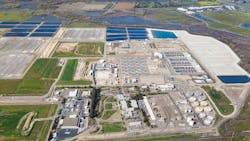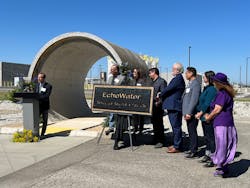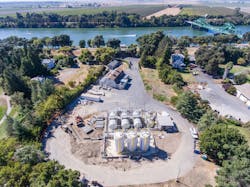After one decade and $1.7 billion across more than 20 projects, the EchoWater Resource Recovery Facility project for Regional San is complete, making it the second largest plant of its kind in the U.S.
Regional San spans a 3,200 acre space between Sacramento, California and Elk Grove, California. Of that space, 1,100 acres are process areas with 2,100 acres of buffer land. It treats 135 million gallons per day for a population of 1.6 million people.
Christoph Dobson, Regional San general manager, said the buffer land was purchased years ago with the recognition that the community would expand and eventually encroach on the treatment plant. Keeping that buffer land allows it to ensure noise, odor and dust are not issues for its neighbors.
The decade-long EchoWater project was initiated following communications from the Central Valley Regional Water Quality Control Board in 2010, when it issued new treatment requirements for Regional San’s wastewater discharge permit.
“That was the very beginning. We had to start planning, design and construction,” Dobson said.
What is EchoWater?
The most critical element of the EchoWater project was ammonia removal. To achieve that, biological nutrient removal (BNR) became the cornerstone for the project’s overall goals. The BNR process spans nearly 18 football fields in size on the facility’s 3,200 acres.
“It’s extremely effective and a very good process,” Dobson said. “We’re removing 99%+ of ammonia in wastewater and about 88% of the total nitrogen.”
The project did not earn any grants and was funded entirely by ratepayers through the use of a Clean Water State Revolving Fund (CWSRF) loan from the California State Water Resources Control Board in the amount of $1.5 billion. It is the largest listed CWSRF loan on the California Water Boards’ website. With the help of that loan and its low interest rate between 1.7 and 1.8%, ratepayers were saved an estimated $500 million in interest payments.
“We were very fortunate we got that,” Dobson said, adding the amount was so large that it impacted the SRF program on a broader scale. “We kind of became a little bit of the villain that had tied up the SRF loans, but it was very effective for us.”
He said, in the end, the project was able to complete the work without the need for all $1.5 billion in the initial loan. He said EchoWater used approximately $1.4 billion in total.
Plant description and flow
Regional San is an advanced tertiary treatment plant, the size of which is only smaller than that of the Blue Plains Advanced WWTP in Washington, D.C. Dobson said Regional San’s permitted capacity is 181 million gallons per day (mgd), but during extreme weather events, it handles more than triple that permitted capacity.
“We’ve been handling flows in excess of 600 million gallons per day during the recent atmospheric river events that we’ve had here in California over the past winter,” Dobson said.
Following the flow of the water into the plant, it is met with bar screens, sediment, and scum and grit removal processes in the primary treatment stage. In the secondary treatment stage, it enters the BNR treatment process, which Dobson said is one of the newer additions to the facility. This stage was vital for meeting the new permit requirements, particularly for ammonia removal.
“Our process at the time was carbonaceous oxidation tanks, and they don’t remove ammonia,” Dobson said of the change in permitting requirements in 2010, “so the BNR is there to remove ammonia.”
“The tertiary process — this is another new process for us — is granular media filtration, so that was a new one that was part of the EchoWater project,” Dobson said. “And then of course we have disinfection contact basins and finally we neutralize the chlorine with sodium bisulfite before we discharge to the Sacramento River.”
Dobson said there is an 800-foot pipeline diffuser that leads to the discharge point at the bottom of the Sacramento River. As for the solids, Regional San uses anaerobic digestion.
“From there, the solids head out to our solids storage basins where they further break down over about a five-year period,” Dobson said. “And then — we like to call it harvesting — we dredge the solids from the bottom and inject those into the soil and disc that into the soil of our lined, dedicated land disposal units.”
Water reuse is the future
On a similar note of values alignment, Regional San currently has a 2 to 3 mgd Title 22 recycled water facility on its plant site, which is used to water local ballfields and landscaping. Some of that recycled water is even provided to an industrial user for a cooling water application.
While the amount is quite small in the grand scheme of Regional San’s efforts, Dobson said the tertiary process that is now in operation treats water to such a degree that it could all fulfill Title 22 requirements as well.
Recycling that water — a project Regional San is calling Harvest Water (see page 8) — is the next evolution for the facility, and it aims to have water flowing by 2025.
“Harvest Water will pump about 50,000 acre feet per year to southern Sacramento County farmers, and they’re going to use that water to irrigate their crops,” Dobson said. “Right now, they all use groundwater so they’re pumping from the ground and, with the drought and everything, that’s over-drafting those groundwater basins.”
One benefit of this process is “in-lieu groundwater recharge,” meaning that reducing groundwater pumping allows for natural recharge of that groundwater. Dobson said that, over the life of the project, the groundwater table is expected to raise by 25 feet. Harvest Water also expects improvements to riparian forest habitats in addition to more sustainable agricultural water use. Half of the $600 million cost is already allotted through grant funding.
Location: Sacramento County, California
Size: 135 average mgd; 181 peak mgd
Equipment: bar screens, sedimentation tanks, scum removal, grit removal, biological nutrient removal, granular sand media filtration, anaerobic digestion, enhanced disinfection
Watch the video
Watch the interview with Cristoph Dobson on Wastewater Digest at https://wwdmag.com/33008123.
About the Author
Bob Crossen
Bob Crossen is the vice president of content strategy for the Water and Energy Groups of Endeavor Business Media, a division of EndeavorB2B. EB2B publishes WaterWorld, Wastewater Digest and Stormwater Solutions in its water portfolio and publishes Oil & Gas Journal, Offshore Magazine, T&D World, EnergyTech and Microgrid Knowledge in its energy portfolio. Crossen graduated from Illinois State University in Dec. 2011 with a Bachelor of Arts in German and a Bachelor of Arts in Journalism. He worked for Campbell Publications, a weekly newspaper company in rural Illinois outside St. Louis for four years as a reporter and regional editor. Crossen can be reached at [email protected].




